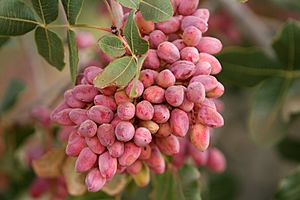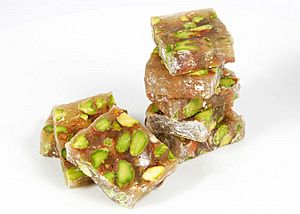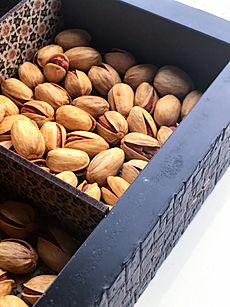Pistachio facts for kids
Quick facts for kids Pistacia vera |
|
|---|---|
 |
|
| Roasted pistachio seed with shell | |
| Conservation status | |
| Scientific classification | |
| Genus: |
Pistacia
|
| Species: |
vera
|
The pistachio (Pistacia vera) is a small tree that comes from Central Asia and the Middle East. It's part of the cashew family. This tree grows tasty seeds that many people enjoy eating.
Sometimes, people get Pistacia vera confused with other types of Pistacia trees that are also called pistachios. You can tell them apart by where they grow naturally and by their seeds, which are usually much smaller and have soft shells.
In 2020, Turkey and the United States grew most of the world's pistachios, making up 68% of the total!
Contents
Where the Word "Pistachio" Comes From
The word "pistachio" has a long history! It came into English from an old French word, "pistace." Later, in the 1500s, it changed to sound more like the Italian word "pistacchio." This Italian word came from Latin, which got it from the Greek word "pistákion." Even further back, it came from an old Persian word, "*pistak."
Pistachio History
Pistachio trees originally grew in parts of Central Asia, like modern-day Iran and Afghanistan. People have been eating pistachio seeds for a very long time! Archaeologists have found evidence that pistachios were a common food as far back as 6750 BC. The oldest proof of people eating pistachios comes from the Bronze Age in Central Asia, specifically from a place called Djarkutan in modern Uzbekistan.
The ancient Romans brought pistachio trees from Asia to Europe in the 1st century AD. Today, these trees are grown all over southern Europe and northern Africa.
Ancient writers like Theophrastus and Dioscorides wrote about the pistachio. Pliny the Elder, another Roman writer, mentioned in his book Natural History that pistachios were well-known. He said the seeds were brought to Italy around 35 AD.
Historians believe the famous Hanging Gardens of Babylon might have had pistachio trees around 700 BC.
In the 1800s, people started growing pistachios for sale in places like Australia, New Mexico, and California. In 1904 and 1905, a person named David Fairchild from the United States Department of Agriculture brought stronger types of pistachio trees from China to California. However, it wasn't until 1929 that growing pistachios became a big business there.
Pistachio Tree Basics
Where Pistachios Grow Best
Pistachios are desert plants, which means they can handle very salty soil. They can even grow well when watered with water that has a lot of salt in it. Pistachio trees are quite tough. They can survive cold winters down to about −10 °C (14 °F) and very hot summers up to 48 °C (118 °F).
These trees need a sunny spot and soil that drains water easily. They don't do well in places with high humidity. If they get too much water in winter and the soil doesn't drain well, their roots can rot. Long, hot summers are important for the fruit to ripen properly.
Tree Characteristics
A pistachio tree can grow up to 10 m (33 ft) tall. Its deciduous leaves are 10–20 centimeters (4–8 inches) long and have a feather-like shape. Pistachio trees are "dioecious," which means there are separate male and female trees. Only the female trees produce fruit. Their flowers don't have petals and grow in clusters called panicles.

The pistachio fruit is a type of drupe, which is a fleshy fruit with a hard pit inside, like a peach or an olive. The edible part is the elongated seed inside. Even though we call it a "nut" when we eat it, botanically speaking, it's actually a seed, not a true nut.
The fruit has a hard, cream-colored outer shell. The seed inside has a purplish skin and light green flesh, with a special flavor. When the fruit is ripe, its shell changes from green to a yellow or red color. Then, it suddenly splits partly open with an audible pop! This splitting is called dehiscence. Humans have chosen to grow pistachio trees that have this splitting trait, as it makes them easier to open.
On average, each pistachio tree produces about 50 kilograms (110 lb) of seeds, or around 50,000 pistachios, every two years.
Pistachio Cultivation
Pistachio trees can live for a very long time, sometimes up to 300 years! They are planted in special farms called orchards. It takes about seven to ten years for a tree to start producing a lot of pistachios. They have a "biennial" harvest, meaning one year they produce a lot, and the next year they produce less. Trees reach their best production around 20 years old.
Farmers often prune the trees to keep them a manageable size, which makes harvesting easier. One male tree can produce enough pollen for eight to twelve female trees to grow fruit. In places like the United States and Greece, machines are often used to shake the pistachios off the trees.
After harvesting, the outer hulls are removed, and the pistachios are dried. Then, they are sorted by whether their shells are open or closed. Finally, they are often roasted or processed to get the kernels out.
In California, almost all female pistachio trees are a type called the Kerman cultivar, which originally came from Kerman, Iran. A small branch from a mature female 'Kerman' tree is often attached to a younger tree's root system to grow new trees.
Pistachio Tree Health
Pistachio trees can get various diseases and be affected by insects. For example, a fungus called Botryosphaeria can cause flowers and young shoots to die, which can harm whole pistachio farms. In 2011, another fungus caused half of Australia's pistachio harvest to be lost. Also, long periods of drought (not enough rain) can cause a big drop in pistachio production.
Pistachio Production
| Country | Production (tonnes) |
|---|---|
| 474,004 | |
| 296,376 | |
| 190,000 | |
| 80,227 | |
| 69,403 | |
| World | 1,125,305 |
| Source: FAOSTAT of the United Nations | |
In 2020, the world produced about 1.1 million tonnes of pistachios. The United States and Turkey were the biggest producers, growing 68% of all pistachios together. Other major producers included Iran, China, and Syria.
In 2019, nearly half of the world's pistachios came from the United States. Production in Iran dropped a lot due to trade rules, climate change, and problems with water management. Some countries in the Caucasus region, like Georgia, also started trying to grow pistachios for international sales.
How People Eat Pistachios

Pistachio kernels are often eaten whole, either fresh or roasted and salted. They are also a popular ingredient in many foods. You can find them in pistachio ice cream, kulfi, and spumoni. People also use them to make pistachio butter, pistachio paste, and sweets like baklava, pistachio chocolate, pistachio halva, and lokum. They are even used in some biscotti and cold cuts like mortadella. In America, some people make a "pistachio salad" with fresh pistachios or pistachio pudding, whipped cream, and canned fruit.
The shell of a pistachio is naturally a light beige color. Sometimes, you might see commercial pistachios dyed red or green. This used to be done to hide stains on the shells from when the nuts were picked by hand. Today, most pistachios are harvested by machines, so the shells usually stay clean and unstained.
Pistachio Nutrition
| Nutritional value per 100 g (3.5 oz) | |
|---|---|
| Energy | 2,351 kJ (562 kcal) |
|
27.51 g
|
|
| Sugars | 7.66 g |
| Dietary fiber | 10.3 g |
|
45.39 g
|
|
| Saturated | 5.556 g |
| Monounsaturated | 23.820 g |
| Polyunsaturated | 13.744 g |
|
Protein
|
20.27 g
|
| Vitamins | Quantity
%DV†
|
| Vitamin A equiv.
lutein zeaxanthin
|
1205 μg
|
| Thiamine (B1) |
76%
0.87 mg |
| Riboflavin (B2) |
13%
0.160 mg |
| Niacin (B3) |
8%
1.300 mg |
| Pantothenic acid (B5) |
10%
0.52 mg |
| Vitamin B6 |
131%
1.700 mg |
| Folate (B9) |
13%
51 μg |
| Vitamin C |
7%
5.6 mg |
| Vitamin D |
0%
0 μg |
| Vitamin E |
15%
2.3 mg |
| Vitamin K |
13%
13.2 μg |
| Minerals | Quantity
%DV†
|
| Calcium |
11%
105 mg |
| Iron |
30%
3.92 mg |
| Magnesium |
34%
121 mg |
| Manganese |
57%
1.2 mg |
| Phosphorus |
70%
490 mg |
| Potassium |
34%
1025 mg |
| Zinc |
23%
2.2 mg |
| Other constituents | Quantity |
| Water | 4 g |
|
Link to USDA database entry
|
|
| †Percentages estimated using US recommendations for adults. | |
Raw pistachios are mostly fat (45%), carbohydrates (28%), and protein (20%). A 100-gram serving of pistachios gives you a lot of food energy. They are also a great source of protein, dietary fiber, and many important dietary minerals. They are especially rich in B vitamins like thiamin and vitamin B6.
Pistachios also contain different types of fats, including healthy monounsaturated fats and polyunsaturated fats. Compared to other tree nuts, pistachios have less fat and fewer calories. They also have more potassium, vitamin K, and other helpful plant compounds like carotenoids.
Pistachios and Your Health
In 2003, the United States Food and Drug Administration said that eating nuts, including pistachios, might help lower the risk of heart disease. They suggested eating about 1.5 ounces (42.5 g) (about a handful) of nuts per day as part of a healthy diet. Even though pistachios provide a good amount of energy, eating them in normal amounts usually doesn't lead to weight gain.
Some early studies have also shown that eating pistachios might help lower blood pressure in people who don't have diabetes mellitus.
Safety Concerns with Pistachios
Like other tree seeds, pistachios can sometimes have a harmful substance called aflatoxin. This happens if they are not harvested or processed correctly. Aflatoxins are strong chemicals made by molds, which can grow on the pistachios from the soil, during poor storage, or spread by pests. If you see gray or black fuzzy mold on pistachios, it's not safe to eat them.
Aflatoxin contamination is a common risk, especially in warm and humid places. Eating food with aflatoxins can cause serious sickness. In some cases, it has even led to deaths.
Pistachio shells usually split open naturally before they are harvested. The hull (outer covering) protects the seed inside from molds and insects. However, if this hull gets damaged in the orchard or after harvest, it's easier for the pistachios to get contaminated. Some pistachios split both their hull and shell early. This "early split" can also lead to aflatoxin contamination. Sometimes, a batch of pistachios might need to be treated to keep the contamination levels low. Other times, a whole batch has to be thrown away because of too much aflatoxin.
Pistachios are part of the same plant family as poison ivy, sumac, mango, and cashew. This means they contain a substance called urushiol, which can cause allergic reactions in some people.
See also
 In Spanish: Pistacia vera para niños
In Spanish: Pistacia vera para niños





